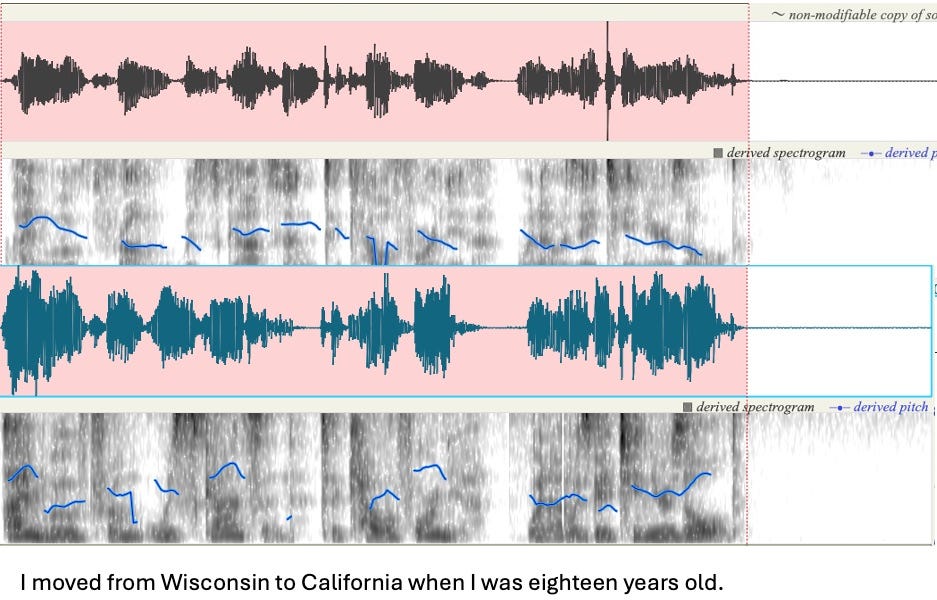Personal Science Week - 251030 Voice
Fixing my accent with voice training
One of the highlights of last week’s biohacking event in Austin was a session led by a renowned voice coach.
This week I’ll summarize a few things I learned about voice analysis, including accent training.
Personal Science Week 251030: Voice
At last week’s Business of Biohacking summit in Austin, I attended a session with Roger Love, a celebrity voice coach who’s worked with everyone from Selena Gomez to Bradley Cooper. As someone who moved from Wisconsin to California at eighteen and still gets feedback about my “Wisconsin twang,” I was curious whether voice training could be quantified and measured like other aspects of personal health.
Turns out it can. Love’s framework breaks voice into five measurable components, each with specific exercises you can track. This isn’t therapy-speak about “finding your authentic voice”—it’s acoustic engineering aimed at producing specific neurological effects in listeners.
The Five Building Blocks
Roger Love teaches that effective speaking requires mastering five interdependent elements:
1. Diaphragmatic breathing: Also called belly breathing, where you breathe deeply into your diaphragm rather than shallowly into your chest. Place one hand on your chest and one on your belly—inhale through your nose for 5 seconds while keeping your chest stable and letting your belly expand. This reduces vocal strain, calms your nervous system through vagal tone activation, and supports vocal stamina. Supposedly there is research showing this reduces cortisol and improves vocal stability.
2. Pitch variation (melody): Varying your pitch to convey emotion and maintain engagement. Monotone delivery kills impact, so Mr. Love teaches specific patterns—particularly his rule about “the most valuable real estate”: raise your pitch before commas (ascending melody) to create anticipation, and lower it before periods (descending melody) to signal authority. Think of it as prosodic programming—you’re hacking listener attention by manipulating pitch contours.
3. Tone (resonance): The quality or “color” of your voice, achieved by balancing airflow and vocal cord vibration. Focus on forward resonance—feeling vibrations in your face rather than throat—to avoid nasal or harsh sounds. Practice by humming and noticing where you feel the vibration.
4. Volume control: Projecting from the diaphragm, not the throat, to speak powerfully without yelling. This protects your vocal cords while ensuring you’re heard clearly. It’s about finding the sweet spot between being audible and straining.
5. Pace: The speed of your speech. Slow down to sound confident and deliberate, while varying pace to emphasize key points. Too fast signals nervousness; too slow drains energy. One practical technique: keep your lips closed before speaking. This prevents filler sounds like “um” and forces you to engage diaphragmatic breathing, ensuring your voice starts strong and controlled.
Read more on Roger Love’s website. Get a good sense of his training style with this 10-minute YouTube video “What Do You Do When Your Voice Sounds Like a Kid?”
Testing with Praat
After the session, I asked Roger Love about my accent. He confirmed the Wisconsin influence and suggested I “lower my jaw more” when speaking. Rather than just take his word for it, I decided to quantify the problem.
I recorded myself saying “I moved from Wisconsin to California when I was eighteen years old” two different ways:
Baseline: My natural speaking voice (
Full Melody: Deliberately lower my jaw to avoid that nasal sound.
Then I analyzed the two waveforms using Praat, professional-grade acoustic analysis software that’s used by phonetics researchers worldwide—and it’s completely free.

The screenshot above shows Praat’s interface. The top shows the waveform (amplitude over time). The middle shows the spectrogram (frequency content—darker regions indicate more acoustic energy). The blue line overlaid on the spectrogram is the pitch contour—this is the fundamental frequency (F0) of my voice over time.
What I found: The “full melody” version showed greater pitch variance than my baseline delivery. The Wisconsin accent was still audible, but noticeably reduced when I focused on Love’s jaw-lowering technique and the ascending/descending melody patterns.
Not quite perfect just yet, but I’m sounding more West Coast every time I practice.
Why Praat Matters
Praat (Dutch for “talk”) was created by Paul Boersma and David Weenink at the University of Amsterdam and has been the gold standard in phonetics research since 1995. It’s open-source, cross-platform (Windows, Mac, Linux), and provides the same acoustic analysis capabilities that would have cost thousands of dollars a generation ago.
Key measurements you can extract:
Pitch: Fundamental frequency over time, plus statistics like mean, standard deviation, and range
Formants: The resonant frequencies that give your voice its characteristic quality
Intensity: Volume in decibels—useful for checking if you’re projecting properly
Speaking rate: Duration measurements for calculating syllables per minute
Voice quality: Jitter, shimmer, and other metrics that indicate vocal strain
The learning curve is real—expect a few hours to get comfortable with the interface—but once you understand the basics, you have professional-grade tools for quantifying voice changes. Download it at praat.org.
Personal Science Weekly Readings
Testing your voice is similar to testing your hearing—both rely on acoustic measurements you can perform yourself. Back in PSWeek240418 we discussed several ways to test your hearing, including a simple iPhone/Airpods test that analyzes frequency response across different pitches.
And since Roger Love emphasizes diaphragmatic breathing as the foundation of voice control, you might revisit PSWeek250417 on breathing.
The weekly newsletter Recomendo is one of my few must-reads, and is always full of tips that I find actually useful. Issue #484 is about Science, with tips including NASA’s list of Citizen Science Projects. I liked the one where you can watch Wisconsin wildlife and then try to classify the images they find on trail cameras.
Speaking of NASA, did you know they broadcast a 24x7 livestream of the Space Station:
Tempted to get a better monitor or wall-size TV? Cambridge researchers tested dozens of sharp-eyed twenty-somethings to calculate the limits of how many pixels per degree (PPD) a human eye can resolve. Answer: “For greyscale images viewed straight on, the average was 94 PPD. For red and green patterns, the number was 89 PPD, and for yellow and violet, it was 53 PPD.” For a typical living room where you sit 10 feet from a 44-in screen, most people can’t tell the difference between 4K and 8K or even a 1440p regular (“quad”) HD.
You can enter your own TV and living room information into their calculator.
The radioactive ‘miracle water’ that killed its believers: A fascinating historical look at how people convinced themselves that radiation was healthy. A reminder that “natural” doesn’t mean safe, and marketing can convince people of anything.
About Personal Science
Personal science means using experimental methods on individual-level problems rather than waiting for big professionally-run clinical trials. This newsletter, published every Thursday, shares ideas and tools for anyone who prefers to do their own research rather than blindly trust credentialed experts.
If you have questions or other topics you’d like to discuss, please let us know.





This would have made for a fascinating Quantified Self Show & Tell. Thanks for another eye-opening post, Richard!